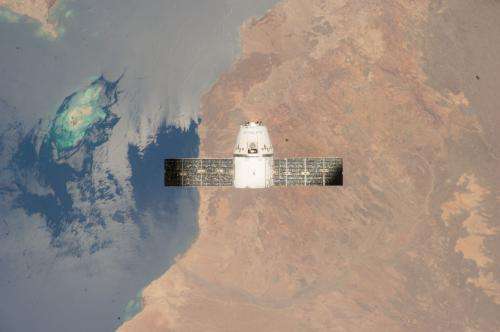Four life science experiments headed to ISS in the SpaceX-5 resupply launch

NASA's Ames Research Center in Moffett Field, California, will launch four life science experiments to the International Space Station aboard NASA's next commercial cargo resupply flight of the SpaceX Dragon spacecraft. The research missions include validation of a new capability for model organism study in space, an infection process investigation in the unique conditions of space, the first step in a multi-part study to track microbes on the space station, and an examination of immune system changes that curiously happen in both elderly people and people exposed to spaceflight.
This launch will deliver more than 5,000 pounds of supplies and scientific experiments, including:
Fruit Fly Lab-01: This validation flight of the Ames-led Fruit Fly Lab provides a research platform aboard the International Space Station for long-duration fruit fly (Drosophila melanogaster) experiments in space. Such experiments will examine how microgravity and other aspects of space affect fruit flies, providing information relevant to long-term human spaceflight, in particular for FFL-01, the response to infection. The lab will be open to principal investigators on the first full science mission, FFL-02, scheduled for late 2015.
Micro-5: This investigation studies how microgravity alters the infection process between host and pathogen. The study focuses on identifying and characterizing the cellular, molecular and immune response mechanisms that play a role in the disease process in microgravity. The experiment is managed and supported by Ames, and the principal investigator is Cheryl Nickerson of Arizona State University in Tempe, Arizona.
Microbial Tracking-1: Microbial Tracking-1A is the first flight in a three-part investigation that seeks to characterize airborne and surface-associated populations of microorganisms aboard the International Space Station. Conducting three separate sampling missions will allow the investigators to assess how the microbial communities aboard the station change over a period of months. Ames is the payload developer and implementer for the Microbial Tracking-1A, and the Space Biology Project at Ames manages the Microbial Tracking-1A investigation. Kasthuri Venkateswaran of NASA's Jet Propulsion Laboratory is the principal investigator for the investigation.
T-Cell Activation in Aging: This second flight in a two-part investigation examines the genetic and molecular mechanisms that underlie diminished T-cell activation that occurs in both the aging population and astronauts. T-cell activation is a critical event during which T-cells, which are specialized immune system cells, recognize infections within the body and initiate a defensive response. Ames is the integration partner and provides science team support to the principal investigator. The National Institute on Aging is the sponsoring agency for the T-cell Activation in Aging mission, and the principal investigator is former NASA astronaut Millie Hughes-Fulford, a researcher at Northern California Institute for Research and Education at the San Francisco Veterans Affairs Medical Center.
Provided by NASA





















